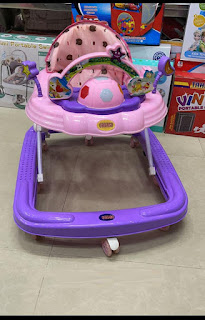Baby Walkers: A Comprehensive Guide

A baby walker is a device designed to assist infants in learning how to walk and explore their surroundings. It consists of a frame with a suspended fabric seat, harness, and wheels, allowing the baby to move around while supported. Here is a complete overview of baby walkers:
1. Purpose and Benefits: Baby walkers primarily encourage and support a baby's walking development. They provide stability and mobility, allowing infants to practice balance, coordination, and leg strength. Additionally, walkers can offer entertainment and stimulation as babies engage with toys and activities attached to the walker.
2. Design and Construction: Baby walkers typically have sturdy frame made of plastic or metal. The seat or harness is attached to the top of the frame and supports the baby's torso while allowing freedom of movement for the legs. The walker has wheels on the base, enabling the baby to move around on flat surfaces.
3. Safety Features: Ensuring the baby's safety is crucial when using a walker. Look for walkers with a broad base for stability, wheel locks or friction strips to prevent rolling on uneven surfaces or stairs, and a height-adjustable seat or harness to accommodate the baby's growth. Using the walker in safe and supervised areas is essential, away from potential hazards.
4. Age and Developmental Stage: Baby walkers are suitable for infants who can hold their heads up steadily and have attempted to stand and take steps with support. The recommended age range for using a walker is typically between 6 and 12 months, but individual development and readiness may vary.
5. Usage and Supervision: It is crucial to use baby walkers under adult supervision at all times. Parents or caregivers should be attentive and ensure the baby is not near any dangers, such as stairs, pools, or other hazards. Limit the duration of walker use to short periods, as excessive time in a walker may hinder natural motor skill development.
6. Alternatives to Traditional Walkers: Recently, concerns have been raised about the safety of traditional baby walkers. As a result, alternatives like stationary activity centers, push toys, and playpens have gained popularity. These options provide similar benefits regarding exploration and activity but without wheels and potential mobility hazards.
7. Parental Considerations: Parents need to weigh the pros and cons of using a baby walker and consider their child's unique needs and developmental progress. Consulting with a pediatrician or healthcare professional can provide valuable guidance on whether a baby walker is appropriate for their child.
Remember, each baby is unique; some may progress differently than others in their walking journey. Always prioritize the safety and well-being of your child, and consider their individual developmental needs when deciding whether or not to use a baby walker.
Tags
Walker
